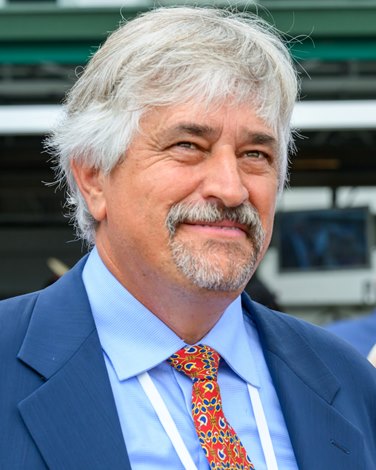Two rulings for positive drug tests against trainer Steve Asmussen were overturned July 3 by a Kentucky circuit court judge.
The rulings, which date back to 2018, center around two postrace test positives for a metabolite of acepromazine, a Class B sedative, called hydroxyethylpromazine sulfoxide, or HEPS. Acepromazine, or ace, is commonly used to tranquilize horses for veterinary procedures.
Franklin Circuit Court Judge Phillip J. Shepherd granted a petition for summary judgment which overturned the Kentucky Horse Racing Commission’s sanctions against Asmussen of $3,500 in fines and a 30-day suspension.
The KHRC claimed that in 2018, Thousand Percent tested positive for HEPS at a level more than seven times the legal limit, while another Asmussen trainee Boldor , tested at approximately twice the legal limit.
Asmussen’s attorney Clark Brewster argued that because ace was not detected in postrace testing his client should not be disciplined.
In his ruling, Shepherd wrote the KHRC “cannot prove that a horse testing positive for over 10 ng/ml of HEPS is ‘conclusive evidence’ of an ace violation. The KHRC has no rational basis to prove that a HEPS positive above the 10 ng/ml threshold means that a trainer administered Ace on race day or that a horse ran a race with Ace present in its system. There is also no admissible evidence in the record that the presence of HEPS has a pharmacological effect on the horse, or that it is a valid proxy for a finding of the illegal use of Ace.”
He wrote the KHRC’s “finding of an Ace violation based solely on the presence of HEPS is sheer speculation.”
Shepherd wrote that the KHRC violated state statutes by “elevating an internal 2013 policy decision—to adopt the voluntary (Racing Medication and Testing Consortium) HEPS thresholds—to the level of mandatory compliance.” The KHRC was also in violation “by arbitrarily finding the horses here ran with Ace in their systems without the support of substantial evidence.
“Guidelines are not mandatory, and the Commission cannot bootstrap a regulatory penalty onto a failure to follow voluntary guidelines, without some independent proof of a violation of an underlying regulatory duty regarding Ace,” Shepherd wrote.
HEPS appears in the KHRC’s “Withdrawal Guidelines” with the threshold for detecting Ace as 10 nanograms per milliliter in urine of HEPS. It has a recommended withdrawal guideline of 48 hours prior to post time when it is administered 0.05 mg/kg intravenously. It was noted that the withdrawal guidelines did not offer guidance when Ace is “administered orally or otherwise not through an IV.” Ace was administered orally to Asmussen’s trainees.
The judge noted that a study “bolsters the argument that the voluntary withdrawal guidelines are themselves not substantial evidence of Ace being present during a race, since oral administration can leave traces of HEPS even beyond the 48-hour suggested guidance for IV administration.
Boldor breaks his maiden at Keeneland



)






